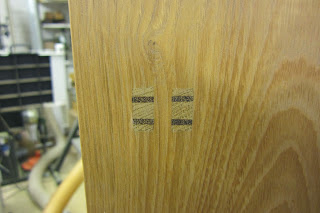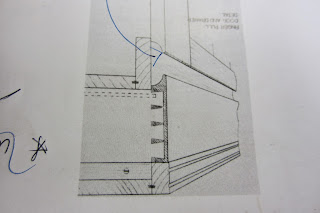Friday 29 November 2013
Wall Cabinet by Alan Peters
I was making room for my latest delivery of dovetail saws when I saw this little cabinet on a high shelf. I bought it from Alan's wife Laura not long after he sadly died, along with a hefty quantity of fine wood.
He used it as a training aid on his trips to the US. It had doors at some stage as there were small hinges fitted but these are missing.
It's only 20" tall and quite cute. I asked Laura whether Alan made it and her reply was a very firm 'Alan would never have kept anything he didn't make himself', that was good enough for me!
This is never going to be a valuable piece, just one of those nice things to own.
The sides are typical of Alan's work using crown cut timber with the arched grain running up the middle.
Two pairs of twin through tenons were used to join the top rail.
The base is through dovetailed and the drawer has half blind dovetails which completes three traditional forms of exposed joinery all in one piece, a great piece for students to copy.
The drawer is also a nice piston fit, another of Alan's trade marks.
The top of the drawer front has an angled rebate which serves as a pull. The diagram below from Alan's great book shows this detail and also shows his intention for opening the missing doors, which will be a great help when I finally get round to making them!
Wednesday 27 November 2013
Craft Show at Midhurst This Weekend
I'll be be exhibiting at the Sussex Guild craft show this Saturday 30th Nov and Sunday 1st Dec. It'll be mostly furniture but I'll have a selection of tools as well. These three boxes will be amongst the items for sale.
There will be 50 makers taking part across many disciplines, including a few quality furniture makers.
Colin Norgate trained at the Barnsley Workshops and makes some lovely pieces. http://www.colinnorgate.co.uk/
Brendon Devitt - Spooner is another fine maker who has a large stash of locally scoured timber. http://www.brendandevitt-spooner.co.uk/
If you're able to go, it will be worth a visit with plenty of quality Christmas presents on offer.
Sunday 24 November 2013
F&C Magazine, Planes on the Cover
The tool cabinet was a project made by the magazine editor Derek Jones and looks a very nice job.
Friday 22 November 2013
The Witch!
If you follow my blog you will remember a recent post on the Prague Marionette and a clown hand puppet. http://davidbarronfurniture.blogspot.co.uk/2013/10/wonderful-puppets-and-marionettes.html
I was so impressed with the detail and expression that I ordered a full working marionette of my favourite, The Witch!
She did not disappoint, now all I have to do is learn how to use one properly.
I tried her out on a pair of two year old twins who visited later that day and I don't think they'll be coming back in a hurry!
The prices are amazingly reasonable for the work, skill and detail that go into making both the hand puppets and the marionettes. Visit the website here http://www.praguemarionette.com/gallery/
Tuesday 19 November 2013
Special Order From Ireland
A few weeks ago I received a couple of blanks of bog oak from Ireland with a request for a chisel hammer and a dovetail marking knife. Here's a batch of hammer handles, it looks like a black sheep!
Bog oak comes from oak trees that fell into peat bogs around 5 million years ago. The cell structure of the wood collapsed but was preserved by the peat bog which turned the wood from dark brown through to jet black in colour. For furniture I like pieces that show the transition from the brown through to black but for small items like this the jet black looks stunning. The wood needs to be retrieved from the bog, no mean task, and then quarter sawn to give it the best chance of drying out without disintegrating. The drying needs to be done slowly and an enormous amount of water is extracted from the collapsed cells which leaves an extremely dense and hard timber when dry, it's almost like stone and is very similar in feel to African blackwood. There are a lot of cracks and shakes as well as areas of rot, so as you can imagine clean defect free boards are just about the most expensive timber you can buy.
Ireland is a good source as well as the fenland's of East Anglia.
I used a boxwood wedge to contrast the black. This hammer has real weight and feels great in the hand, I hope I've done this rare wood justice.
Sunday 17 November 2013
Quality Japanese Saw
At the David Stanley auction last week I picked up this delicate unused Ryoba saw from one of the stalls. I recognised the label from Thanet Tools Supplies in their Craftsman Choice catalogue. The entry describes the saw as being made by master blacksmith Kijima San. Each blade is hand scraped to produce the correct tapering towards the blade centre and has hand cut teeth which are machine set for accuracy and then hand finished. The price label was 15 - 20 years old so this saw would be well over £100 now.
Although Thanet Tools Supplies is going strong the Japanese tools have all but finished a few years ago which is a great shame. I think a combination of the vast range of stock and British conservatism prevented it being a viable concern. The catalogue is 84 pages with over 1,000 lines and is a great read if you can get hold of one.
I picked up these rare planes made by Arthur Price, the last of the old makers who worked from 1924 - 1967. They are in great condition and have seen very little use. If anyone can shed any more light on his activities I would appreciate hearing from them.
I also succumbed to another Bill Carter plane, this time a 6 1/4" mitre plane in boxwood.
Bill says these take him nearly as long to make as his metal planes but can only sell them for 1/3 of the price.
It has wonderful lines and feels great in the hand. He has a few more if anyone is interested.
Friday 15 November 2013
Dedication to the Craft.
Just in case anyone doubted my dedication to the craft, here's a couple of shots of my after shave!!!
Come on, I'm allowed a jovial post once in a while!
Sunday 10 November 2013
Scottish Smoother Finished!
With the clamps off, the block was flushed with the plane and then cut to rough shape with a fine coping saw by Knew Concepts. I then used rasps to refine the curves to a pleasing shape which blended in with the original. This went quicker than I expected, mahogany is much softer than rosewood although it's very easy to remove too much! The method of attaching and clamping the new spur worked very well with a tight joint and no glue line.
The colour was not exactly a perfect match due to both age and the fact the original had been stained. I used a combination of coloured shellac and permanent markers pens to blend the new spur in.
The new handle fitted nicely and gave a comfortable grip.
Here's the finished handle. I sealed the colour with a couple of coats of tinted melamine lacquer which was applied to the whole plane. This was then lightly cut back with 600 grit and waxed.
Before applying the lacquer I 'distressed' the new spur (with a bunch of keys) to blend in with the knocks and bumps of the rest of the wood. The result was pleasing and you really wouldn't suspect it had been repaired.
Here's the spur compared to the Galloway plane.
Wednesday 6 November 2013
Scottish Smoother From E Bay.
This is my most recent E Bay purchase. The pictures on the advert weren't great but for £68 including postage I wasn't risking much, especially as the parallel Ward and Payne blade is worth half that alone.
Obviously the rear handle needed repairing but this is not difficult or time consuming. The plane itself was much better than I expected with nicely over stuffed infills and no damage to the metal.
I have a Scottish smoother by Galloway which gives me something to go by, although even this has a repaired spur.
It's interesting to see the difference in the angle of the spur compared to this Matheison smoother from the same late Victorian period.
My method for cleaning up the broken handle is to run it against the fence of my table saw. This gives a perfectly parallel surface to the sole which makes for easy clamping.
The cut revealed a nail which had presumably been used to reattach the broken spur at some time in the past. It also showed the infill wood to be mahogany, which I suspected, rather than rose wood.
I decided to make a second deeper cut to remove any roundness to the sides and to take off more of the nail.
The nail was recessed with a punch to avoid nay risk of fouling the glue up.
I raided my stocks of old Cuban mahogany and chose a piece with the grain running in the same direction.
Here's a shot of the glue up which should yield an invisible glue line.
The fun (and time consuming) part comes next, I'll keep you posted.
Subscribe to:
Posts (Atom)











































